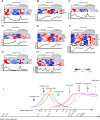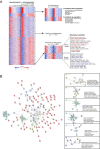Transcriptomic Analysis of the Developmental Similarities and Differences Between the Native Retina and Retinal Organoids
- PMID: 32150248
- PMCID: PMC7401421
- DOI: 10.1167/iovs.61.3.6
Transcriptomic Analysis of the Developmental Similarities and Differences Between the Native Retina and Retinal Organoids
Abstract
Purpose: We performed a bioinformatic transcriptome analysis to determine the alteration of gene expression between the native retina and retinal organoids in both mice and humans.
Methods: The datasets of mouse native retina (GSE101986), mouse retinal organoids (GSE102794), human native retina (GSE104827), and human retinal organoids (GSE119320) were obtained from Gene Expression Omnibus. After normalization, a principal component analysis was performed to categorize the samples. The genes were clustered to classify them. A functional analysis was performed using the bioinformatics tool Gene ontology enrichment to analyze the biological processes of selected genes and cellular components.
Results: The development of retinal organoids is slower than that in the native retina. In the early stage, cell proliferation predominates. Subsequently, neural differentiation is dominant. In the later stage, the dominant differentiated cells are photoreceptors. Additionally, the fatty acid metabolic process and mitochondria-related genes are upregulated over time, and the glycogen catabolic process and activin receptors are gradually downregulated in human retinal organoids. However, these trends are opposite in mouse retinal organoids. There are two peaks in mitochondria-related genes, one in the early development period and another during the photoreceptor development period. It takes about five times longer for human retinal development to achieve similar levels of mouse retinal development.
Conclusions: Our study reveals the similarities and differences in the developmental features of retinal organoids as well as the corresponding relationship between mouse and human retinal development.
Conflict of interest statement
Disclosure:
Figures








Similar articles
-
Cell Types of the Human Retina and Its Organoids at Single-Cell Resolution.Cell. 2020 Sep 17;182(6):1623-1640.e34. doi: 10.1016/j.cell.2020.08.013. Cell. 2020. PMID: 32946783 Free PMC article.
-
Generation, transcriptome profiling, and functional validation of cone-rich human retinal organoids.Proc Natl Acad Sci U S A. 2019 May 28;116(22):10824-10833. doi: 10.1073/pnas.1901572116. Epub 2019 May 9. Proc Natl Acad Sci U S A. 2019. PMID: 31072937 Free PMC article.
-
Improved Retinal Organoid Differentiation by Modulating Signaling Pathways Revealed by Comparative Transcriptome Analyses with Development In Vivo.Stem Cell Reports. 2019 Nov 12;13(5):891-905. doi: 10.1016/j.stemcr.2019.09.009. Epub 2019 Oct 17. Stem Cell Reports. 2019. PMID: 31631019 Free PMC article.
-
Application of Human Stem Cell Derived Retinal Organoids in the Exploration of the Mechanisms of Early Retinal Development.Stem Cell Rev Rep. 2023 Aug;19(6):1755-1772. doi: 10.1007/s12015-023-10553-x. Epub 2023 Jun 3. Stem Cell Rev Rep. 2023. PMID: 37269529 Review.
-
Human Organoids for the Study of Retinal Development and Disease.Annu Rev Vis Sci. 2020 Sep 15;6:91-114. doi: 10.1146/annurev-vision-121219-081855. Annu Rev Vis Sci. 2020. PMID: 32936736 Review.
Cited by
-
Bioengineering Human Pluripotent Stem Cell-Derived Retinal Organoids and Optic Vesicle-Containing Brain Organoids for Ocular Diseases.Cells. 2022 Oct 30;11(21):3429. doi: 10.3390/cells11213429. Cells. 2022. PMID: 36359825 Free PMC article. Review.
-
Whole transcriptome sequencing identifies key circRNAs, lncRNAs, and miRNAs regulating neurogenesis in developing mouse retina.BMC Genomics. 2021 Oct 30;22(1):779. doi: 10.1186/s12864-021-08078-z. BMC Genomics. 2021. PMID: 34717547 Free PMC article.
-
Stage-specific dynamic reorganization of genome topology shapes transcriptional neighborhoods in developing human retinal organoids.Cell Rep. 2023 Dec 26;42(12):113543. doi: 10.1016/j.celrep.2023.113543. Epub 2023 Dec 3. Cell Rep. 2023. PMID: 38048222 Free PMC article.
-
Generating ESC-Derived RGCs for Cell Replacement Therapy.Methods Mol Biol. 2025;2848:187-196. doi: 10.1007/978-1-0716-4087-6_12. Methods Mol Biol. 2025. PMID: 39240524 Free PMC article.
-
Retinal organoids: a window into human retinal development.Development. 2020 Dec 24;147(24):dev189746. doi: 10.1242/dev.189746. Development. 2020. PMID: 33361444 Free PMC article. Review.
References
-
- Bassett EA, Wallace VA. Cell fate determination in the vertebrate retina. Trends Neurosci. 2012; 35: 565–573. - PubMed
Publication types
MeSH terms
Substances
LinkOut - more resources
Full Text Sources

